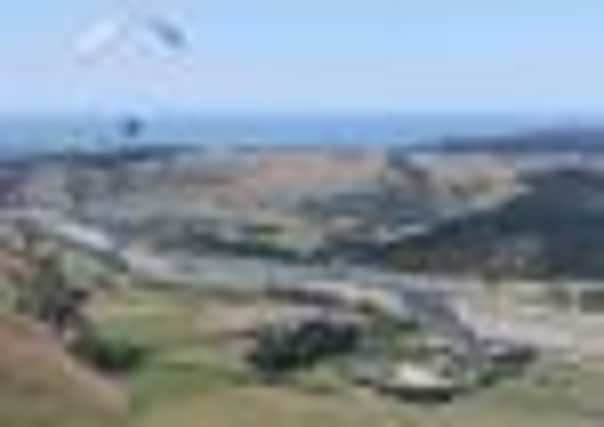Escape from the stone age


Ever since those fresh herbaceous flavours swept across our palates, we have been in love with New Zealand Sauvignon, but this is much more than a one-variety country. Away from the broad expanse of Marlborough, there are different soil structures and climates which are perfect for a whole range of grapes and Hawkes Bay on North Island is proving exceptionally good for reds. Situated on the dry eastern side of North Island, Hawkes Bay is one of New Zealand’s oldest wine growing regions, first planted in the mid 19th century. It is pretty much ideal with more sunshine than anywhere else in New Zealand, warm temperatures, tempered by its closeness to the sea, a mix of soils and a good supply of water for irrigation.
This is home to New Zealand’s best market gardens which was demonstrated by the aromatic boysenberries and the multitude of fresh fruit and veg that was in the car when Steve Smith, Master of Wine and MD of Craggy Range winery, picked me up for a visit to the winery.
Advertisement
Hide AdAdvertisement
Hide AdThe key factor in Hawkes Bay is not the fertile soil – which is great for boysenberries – but the deep stretch of gravel which was exposed when the River Ngaruroro changed its course during a flood in 1867.
There are rumours that this was a deliberate attempt by someone upstream to acquire more land. Whether that worked for the landowner is lost in time, but by changing its course of the river the rounded stones which had previously formed the bed of the river were exposed, leaving a rocky landscape that was of no use to anyone.
The area became a wasteland and in some places it was used as the local dump until 30 years ago when a gravel extraction company wanted to take it over for their cement business. That is when the local grape growers decided that it would be a lot more use as vineyard and now the Gimlett Gravels is one of the most distinctive soils in the whole of New Zealand. The unique stony soil, free draining, with low fertility and the ability to hold the daytime heat in the stones is now famous for the quality of its reds, in particular rich flavoured Cabernets, Merlots and Syrah.
That Craggy Range has invested its $70m in its Hawkes Bay vineyards complete with a show-piece winery, visitor centre and restaurant demonstrates its confidence in this region. It also has vineyards scattered through the rest of the country.
Advertisement
Hide AdAdvertisement
Hide AdWhen I tasted through the range, there wasn’t a wine out of place, each one reaching that little bit further for aromatics, depth of flavour and suppleness. The wines have a sheen of excellence that makes them a certain choice.
Try Craggy Range Syrah 2008 from the Gimlett Gravels (£18.99 Waitrose) for its deep plummy fruit with lush savoury notes and a distinct sprinkle of pepper on the finish. Craggy Range Merlot 2009 (£15.99 Waitrose) also has distinctive, deep characterful red fruit flavours, with soft tannins but enough backbone to take on roast lamb or a steak.
Craggy Range also has a more affordable, approachable range of wines known as Wild Rock which provide great flavour for money. Try Wild Rock Gravel Pit Red 2008 made from Merlot and Malbec which is also available at Waitrose, although Penistone Wine Cellars (01226 766037) manage to price slightly cheaper at £10.90.
But not everyone started out with $70m to invest. Te Mata is a family wine business that was first planted in 1892 and over the decades became run down until it was bought in the 1970’s by John Buck. He has gradually restored and expanded the estate and now has vineyards at three key points across the region. The result is a top-quality property capable of producing fine wines and reds. In particular I enjoyed Te Mata Bullnose Syrah 2010 which combines warm raspberry and plum notes with peppery tones and a silky texture.
Advertisement
Hide AdAdvertisement
Hide AdThis is not a block-buster wine, more delicate and food-friendly. Find it at The Halifax Wine Company, £24.50. Halifax also has the distinctive and elegant Cabernet Merlot blend, Te Mata Coleraine, (£31.95 for the 2006 vintage) which stands out as one of New Zealand’s finest reds.
Trinity Hill, run by John Hancock is another winery that has taken many years to achieve its current quality status, which was demonstrated by its wines sweeping the board at the recent Sydney International Wine Show. Trinity Hill Gimlett Gravels Syrah 2010 won best wine in the Show and a handful of other wines came in the top 100. These wines are not so easy to find in our region, although Penistone Wine Cellars has the Syrah 2005 at £16.11. In a tasting through some of the range I particularly enjoyed Homage Syrah 2009 which stood out for its intensity and concentrated black fruit flavours and positive finish while the Tempranillo 2009 showed that there is a lot more to Hawkes Bay than Syrah and Bordeaux varietals. .
Other significant producers of the region include the organically run Moana Park (Bon Coeur Fine Wines) who make a particularly good Viognier and the equally organic Te Awa whose wines are just becoming established in the region. Both properties use sheep to nibble the grass under the vines and to remove the leaves that would otherwise shade the developing grapes. Antony Mackenzie of Te Awa said: “Because the sheep graze the vines, we don’t use copper sprays which would affect them.” However they do plant a range of herbs between the rows to attract all the right insects. I wonder if that includes a bouquet garni of garlic, rosemary and mint?